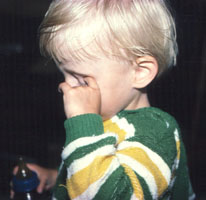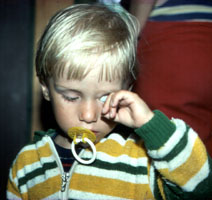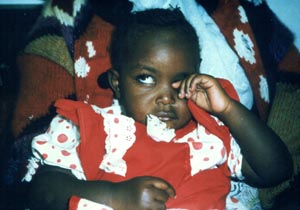'Blindisms', stereotype behaviours
Visually impaired infants sometimes start pressing on their eyes, which may develop to eye poking. The causes are not obvious but often self stimulation seems to be more frequent when the infant is not occupied by play or communication. Eye poking causes pressure atrophy of fat tissue in the orbit and of the bony rim of the orbit. Often the skin around the eye becomes darker. The deep set eye is a cosmetic problem that may disturb the child later in life. It is also possible that eye poking leads to detachment of the retina. Because the child does not tell anybody about the change in vision, retinal detachment is usually noticed so late that surgical results are poor. One symptom that we should be aware of, is hitting of forehead: if an infant or child starts to hit his/her forehead now and then and then quiets as if watching something in front of him/her, the interesting phenomenon to watch might be lights, flashes produced by movement in the detaching retina.



The boy lost his vision due to retinal retachment. - Eye pressing and eye poking occur on all continents.
Rocking of head or body, jumping and waving hands are other stereotypic behaviours which may develop in otherwise well functioning infants. Since they are later problematic in social situations it is wise to help the child back toward normal motor development. Increased activity of hands, exploration of the environment and changing the stereotypic movements to normal play activity as soon as they start usually diminishes them. Eye poking can be prevented by using glasses with side shields but they must be introduced immediately when eye pressing starts. Otherwise the little fingers find they way around the edge of the glasses.

The first signs are usually not noticed by the parents. Therefore people involved with the care of the visually impaired infants need to be active in keeping an eye on each infant and in helping the parents to prevent development of mannerisms.